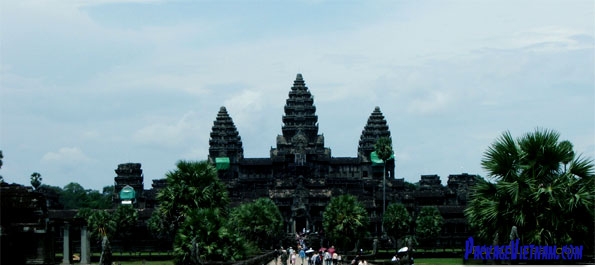
State & Law
Country name: Kingdom of Cambodia
Local short form: Kampuchea
Former: Kingdom of Cambodia, Khmer Republic, Democratic Kampuchea, People's Republic of Kampuchea, State of Cambodia
Local long form: Preahreacheanacha Kampuchea (phonetic pronunciation)
Government type: multiparty democracy under a constitutional monarchy established in September 1993
Capital: Phnom Penh
Administrative divisions: 20 provinces (khaitt, singular and plural) and 4 municipalities (krong, singular and plural) ;
Provinces: Banteay Mean Chey, Batdambang, Kampong Cham, Kampong Chhnang, Kampong Spoe, Kampong Thum, Kampot, Kandal, Koh Kong, Kracheh, Mondol Kiri, Otdar Mean Chey, Pouthisat, Preah Vihear, Prey Veng, Rotanakir, Siem Reab, Stoeng Treng, Svay Rieng, Takao
Municipalities: Keb, Pailin, Phnom Penh, Preah Sihanouk (formerly Kompong Som)
Independence: 9 November 1953 (from France)
National holiday: Independence Day, 9 November (1953)
Constitution: promulgated 21 September 1993
Legal system: primarily a civil law mixture of French-influenced codes from the United Nations Transitional Authority in Cambodia (UNTAC) period, royal decrees, and acts of the legislature, with influences of customary law and remnants of communist legal theory; increasing influence of common law in recent years
Suffrage: 18 years of age; universal
Executive branch:
Chief of state: King Norodom SIHANOUK (reinstated 24 September 1993)
Head of government: Prime Minister HUN Sen (since 14 January 1985) and Deputy Prime Ministers SAR Kheng (since 3 February 1992), Prince SIRIVUDH, SOK An, LU Laysreng, TEA Banh, HOR Namhong, NHEK Bunchhay (since 16 July 2004)
Elections: none; the monarch is chosen by a Royal Throne Council; following legislative elections, a member of the majority party or majority coalition is named prime minister by the Chairman of the National Assembly and appointed by the king .
Cabinet: Council of Ministers in theory appointed by the monarch; in practice named by the prime minister.
Legislative branch: bicameral consists of the National Assembly (123 seats; members elected by popular vote to serve five-year terms) and the Senate (61 seats; two members appointed by the monarch, two elected by the National Assembly, and 57 elected by "functional constituencies"; members serve five-year terms)
Election results: National Assembly - percent of vote by party - CPP 47%, SRP 22%, FUNCINPEC 21%, other 10%; seats by party - CPP 73, FUNCINPEC 26, SRP 24; Senate - percent of vote by party - NA; seats by party - CPP 31, FUNCINPEC 21, SRP 7, other 2 (July 2003)
Elections: National Assembly - last held 27 July 2003 (next to be held in July 2008); Senate - last held 2 March 1999 (scheduled to be held in 2004 but delayed)
Judicial branch:
Supreme Council of the Magistracy (proved for in the constitution and formed in December 1997); Supreme Court (and lower courts) exercises judicial authority
Political parties and leaders:
Cambodian Pracheachon Party (Cambodian People's Party) or CPP [CHEA Sim];
National United Front for an Independent, Neutral, Peaceful, and Cooperative Cambodia or FUNCINPEC [Prince NORODOM Ranardh];
Sam Rangsi Party or SRP [SAM Rangsi]
Political pressure groups and leaders: NA
International organization participation:
ACCT, ARF, AsDB, ASEAN, CP, FAO, G-77, IBRD, ICAO, ICCt, ICRM, A, IFAD, IFC, IFRCS, ILO, IMF, IMO, Interpol, IOC, IOM, ISO (subscriber), ITU, NAM, OPCW (signatory), PCA, UN, UNCTAD, UNESCO, UNO, UPU, WCO, WFTU, WHO, WIPO, WMO, WToO, WTrO (observer)
Flag description: three horizontal bands of blue (top), red (double width), and blue with a white three-towered temple representing Angkor Wat outlined in black in the center of the red band; only national flag to incorporate a building in its design







